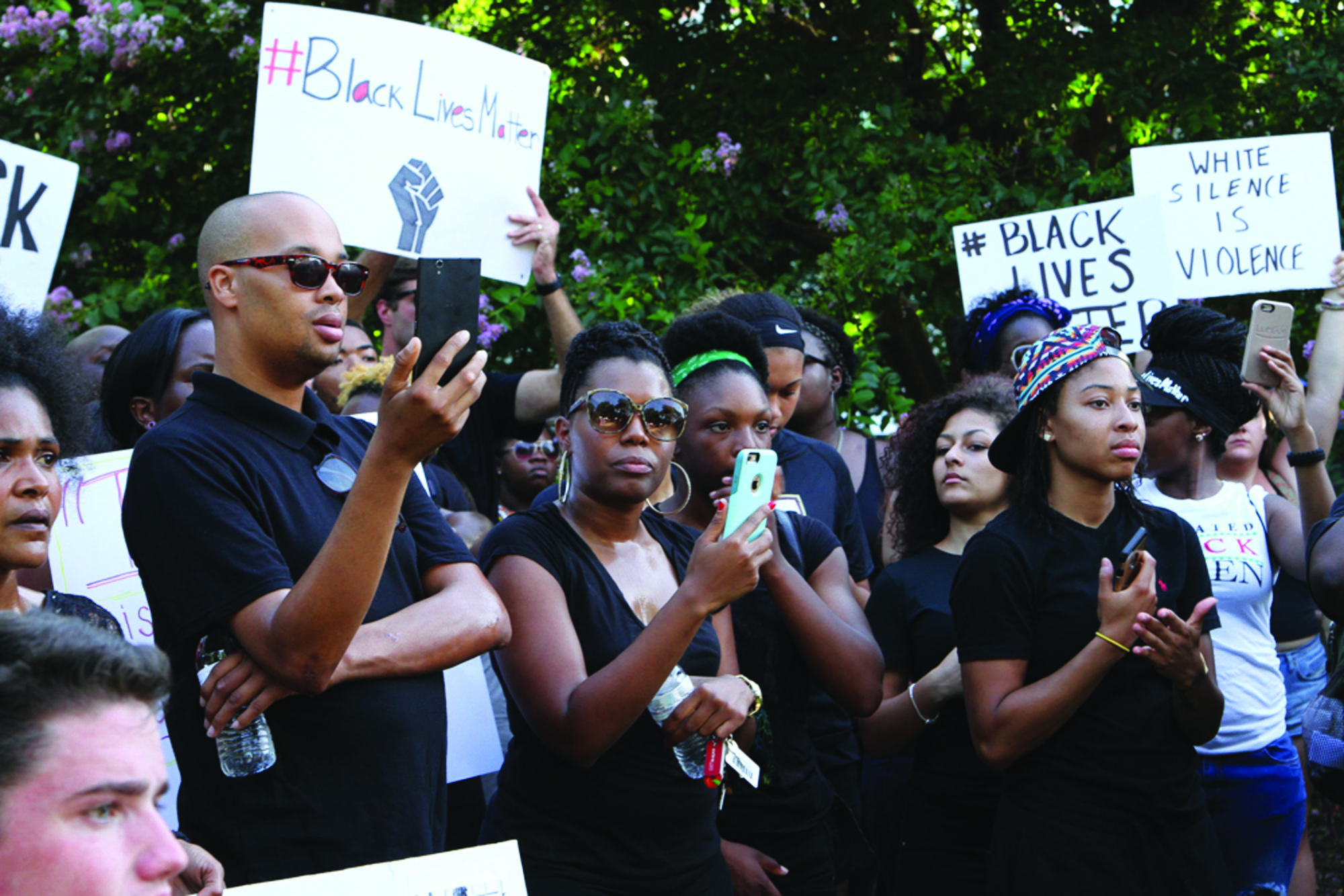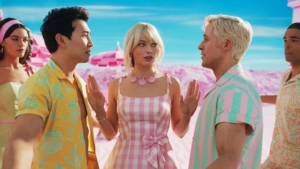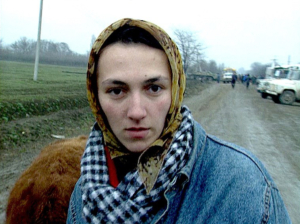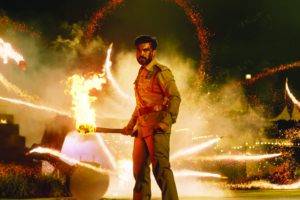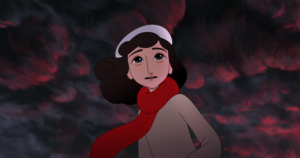Citizen journalism has reached its apotheosis in the digital age. Although eyewitness reportage predates the information revolution, its rise coincides with the evolution of accessible recording devices and the democratisation of media outlets. Modern citizen journalism can be traced back to one of the most important films in history: bystander Abraham Zapruder’s home-movie recording of the assassination of then–US president John F Kennedy on 22 November 1963.[1]See Steve Rose, ‘Abraham Zapruder: The Man Behind History’s Most Infamous Home Movie’, The Guardian, 15 November 2013, <https://www.theguardian.com/film/2013/nov/14/abraham-zapruder-film-kennedy-killing-parkland>, accessed 17 November 2020. This inadvertent capturing of an unforeseeable event simultaneously created its own offshoot: accidental journalism.[2]See Stuart Allan & Einar Thorsen, ‘Introduction’, in Allan & Thorsen (eds), Citizen Journalism: Global Perspectives, Peter Lang, New York, 2009, p. 4. Many more amateur films have since accidentally borne witness to historic events, including the 1991 beating of Rodney King by police and subsequent LA Riots, the September 11 terrorist attacks in 2001, and the 2004 Asian tsunami.
It required digital technologies, however, to make it possible for citizens to reach out to one another and pass on information in real time, including eyewitness reports of social unrest (such as the Arab Spring and the Occupy movement), civil war, natural disasters and the ongoing COVID-19 pandemic.[3]See my article in the previous issue of Metro for a more critical look at this form of citizen journalism, which seemed intent on spreading misinformation and racial animus through social media: Steven Aoun, ‘Pandemic Paradox: Navigating Technology in the Time of COVID-19’, Metro, no. 206, 2020, pp. 100–5. The ubiquity of the mobile phone[4]US agency We Are Social reports that there are now over 5.19 billion unique mobile-phone users across the globe, and at least 4.54 billion people are connected to the internet in some way. See We Are Social, Digital 2020: Global Digital Overview, 2020, <https://wearesocial.com/digital-2020>, p. 8. – and prevalence of social-media accounts – has potentially turned everyone into an accidental journalist, and there is arguably no more momentous recent instance of citizen journalism playing a key role in historic change than the recordings that sparked the 2020 Black Lives Matter protests.[5]See Jenna Wortham, ‘A “Glorious Poetic Rage”’, The New York Times, 5 June 2020, <https://www.nytimes.com/interactive/2020/07/03/us/george-floyd-protests-crowd-size.html>, accessed 17 November 2020.
Caught on camera
The demonstrations by Black Lives Matter activists against systemic racism and police brutality in 2020 spoke to the power of the moving image. Two separate videos from last year – each recorded on the same day, 25 May – proved to be particularly mobile and powerful.
The first documents a white woman, Amy Cooper, calling 911 and falsely claiming that the black man asking her to observe a park ordinance, Christian Cooper, is acting in a threatening manner. In the video, the avid birdwatcher requests that she put her dog on a leash, and she counters, warning, ‘I’m taking a picture and calling the cops … I’m going to tell them there’s an African-American man threatening my life.’[6]Jan Ransom, ‘Amy Cooper Faces Charges After Calling Police on Black Bird-watcher’, The New York Times, updated 14 October 2020, <https://www.nytimes.com/2020/07/06/nyregion/amy-cooper-false-report-charge.html>, accessed 19 November 2020. It’s pretty clear, however, what she really felt threatened by: the camera filming her. Perhaps that’s why she cast herself in the role of damsel in distress and played to the camera accordingly. The most telling thing about the recording, however, is her offensive manoeuvre: we see her instinctively weaponise her race in order to gain control of a public space. Like many white civilians before her, she attempted to mobilise the armed forces of law and order against a defenceless black civilian so as to force him into a state of servitude.[7]Well before the Central Park incident, African-Americans had been reporting increasing incidents of racial profiling on social media. While racial profiling is typically viewed as an aspect of (racist) police policy, many ordinary white people appear to view ‘being black’ as a crime in progress, and routinely call the police when encountering perceived criminals in shared public places. Some of their ‘crimes’ include taking a nap, having a barbecue, sitting at Starbucks, cashing a cheque, mowing a lawn, going to a store, taking a swim and entering their own apartment blocks. See Brett Molina, ‘Cashing Checks, Napping, More Activities Leading to Police Calls on Black People in 2018’, USA Today, 20 December 2018, <https://www.usatoday.com/story/news/nation/2018/12/20/black-people-doing-normal-things-who-had-police-called-them-2018/2374750002/>, accessed 19 November 2020. Viewers of the recording not only saw a disturbing instance of racial profiling traditionally associated with the criminal justice system,[8]See Stephen Egharevba, Police Brutality, Racial Profiling, and Discrimination in the Criminal Justice System, IGI Global, Hershey, PA, 2017. but also received a history lesson in systemic racism within ninety seconds.
The trajectory of these moving images proves (at least) one thing beyond reasonable doubt: some of today’s most important films are being made and distributed by ordinary citizens.
The second, more incendiary, video shows white police officer Derek Chauvin killing George Floyd, a black man, in slow motion in front of eyewitnesses – one of whom, seventeen-year-old black girl Darnella Frazier, was recording the incident from a couple of metres away on her camera phone as Floyd pleaded for his life.[9]Joshua Nevett, ‘George Floyd: The Personal Cost of Filming Police Brutality’, BBC News, 11 June 2020, <https://www.bbc.com/news/world-us-canada-52942519>, accessed 17 November 2020. This is by far the more horrifying footage; unlike the dog walker, however, the police officer appears completely unperturbed by the fact that he is on candid camera, and ignores the protests of the crowd gathering around the imminent crime scene. It’s likely that Chauvin was feeling emboldened by the four police body cameras also shooting on location. Raw footage – released to the media nearly three months after the incident – provides a more complete picture and reframes the circumstances of Floyd’s seizure.[10]See ‘RAW: George Floyd Minneapolis Police Body Camera Footage’, YouTube, 10 August 2020, <https://www.youtube.com/watch?v=0gQYMBALDXc>, accessed 19 November 2020. Floyd can be seen resisting arrest for over eight minutes and repeatedly saying, ‘I can’t breathe,’ before he is forced to the ground and his neck is knelt upon for nine excruciating minutes. Nonetheless, the police officers remain curiously unconcerned by the possibility that the panicked suspect might succumb to cardiac arrest instead while restrained and in custody.[11]For a more detailed examination of Floyd’s death, see Judy Melinek, ‘Forensic Pathologist Breaks Down George Floyd’s Death’, MedPage Today, 25 June 2020, <https://www.medpagetoday.com/blogs/working-stiff/86913>, accessed 19 November 2020. The reason for their nonchalance is self-evident: the law is historically on white people’s side, and police are rarely prosecuted (and usually exonerated if brought to trial) when killing black ‘suspects’.[12]Some relevant statistics can be found at the Mapping Police Violence website, <https://mappingpoliceviolence.org/>, accessed 19 November 2020.
The image of a white man’s knee on a black person’s neck provided a perfect metaphor for race relations around the world. Floyd’s death also offered a perverse mirror image of a recent symbolic stance: ‘taking a knee’, as popularised by NFL player Colin Kaepernick in 2016, had previously been a method of calling attention to police brutality and systemic racism in a non-violent manner.[13]Kaepernick’s goal was twofold: to raise white awareness about black deaths in custody, and to indicate peaceful resistance to systemic racism during the playing of the US national anthem. See Les Carpenter, ‘Kaepernick’s Anthem Protest Is Perfect Way to Highlight America’s Race Problem’, The Guardian, 9 September 2016, <https://www.theguardian.com/sport/2016/sep/09/colin-kaepernick-national-anthem-protest-nfl-race-issues>, accessed 19 November 2020. Further, the casual disregard for Floyd’s life acts as a preview of the fate that could have befallen Christian Cooper had he still been in the park when the authorities arrived.
A third viral video, recorded on 15 June, helps sum up the fraught role of camera phones in contemporary US race relations. In this recording, a white couple, Lisa Alexander and Robert Larkins, can be seen confronting and (in the latter’s case) filming a person of colour, James Juanillo, who is in turn filming them.[14]Kenya Evelyn, ‘CEO Caught on Video Confronting Neighbour over Black Lives Matter Message’, The Guardian, 16 June 2020, <https://www.theguardian.com/us-news/2020/jun/15/ceo-lisa-alexander-faces-backlash-video-berating-james-juanillo>, accessed 19 November 2020. In this case, each party is documenting their dispute over Juanillo chalking the words ‘Black Lives Matter’ on his own home; the white couple falsely claim that they know the property owner, and subsequently say that they will call the police. Particularly telling in this case is the dual – and duelling – recordings. In this video, mobile camera phones instinctively become each participant’s weapon of choice: their combat is being fought according to an accepted code of procedure, from twenty paces away and in the presence of potential witnesses much further afield. Consequently, shared video footage can be used to either vindicate or incriminate complainants in competing spheres (that is, the court of public opinion or a court of law).
The trajectory of these moving images proves (at least) one thing beyond reasonable doubt: some of today’s most important films are being made and distributed by ordinary citizens. Private video surveillance can rapidly enter the public sphere, and the threat of becoming the subject of a viral video has quickly become a tool to police other people’s behaviour. As these public indictments have moved from device to device and through various distribution channels, citizen journalists have thereby been able to speak truth to power and invert the hierarchy of credibility, or the way representations of reality are distributed according to perceived social status and authority.[15]See Howard S Becker, ‘Whose Side Are We On?’, Social Problems, vol. 14, no. 3, Winter 1967, p. 241. Digital media’s sites of resistance are therefore calling into question the authority of institutionalised and centralised sources of meaning and truth. In the case of Floyd’s death, members of the police force – the very institution charged with serving and protecting the public – stand publicly accused of an indictable offence as a direct result of citizen journalism.
Significantly, those at the top of the credibility hierarchy have followed the lead of bottom-up or decentralised social media, and also sought to try Floyd’s case in the court of public opinion. The New York Times and The Washington Post reconstructed the sequence of events leading up to his death and edited together footage from disparate sources – CCTV cameras, witness videos, official documents and so on – in a somewhat more literal example of ‘trial by media’.[16]See Evan Hill et al., ‘How George Floyd Was Killed in Police Custody’, The New York Times, updated 5 November 2020, <https://www.nytimes.com/2020/05/31/us/george-floyd-investigation.html>; and Dalton Bennett, Joyce Sohyun Lee & Sarah Cahlan, ‘The Death of George Floyd: What Video and Other Records Show About His Final Minutes’, The Washington Post, 30 May 2020, <https://www.washingtonpost.com/nation/2020/05/30/video-timeline-george-floyd-death/>, both accessed 19 November 2020. The extrajudicial proceedings, however, have merely drawn attention to these authorities’ prior complicity in reinforcing systemic racism and historical reluctance to challenge sources typically relied upon.[17]See Jonathan Markovitz, Racial Spectacles: Explorations in Media, Race, and Justice, Routledge, New York & Abingdon, UK, 2011. Specifically, if not for the videos of citizen journalists, Floyd’s death would most likely have gone without much notice or comment and/or been filtered through the lens of official police reports. It required private recordings of a black man dying on the corner of 38th Street and Chicago Avenue in Minneapolis, Minnesota, to trigger a chain of unforeseen events across six continents and sixty countries. This mobile footage set in motion a racial reckoning via the cascading and reciprocal effects of multiple media outlets, including waves of civil unrest, corporate support for protests and shifting power dynamics within popular culture.
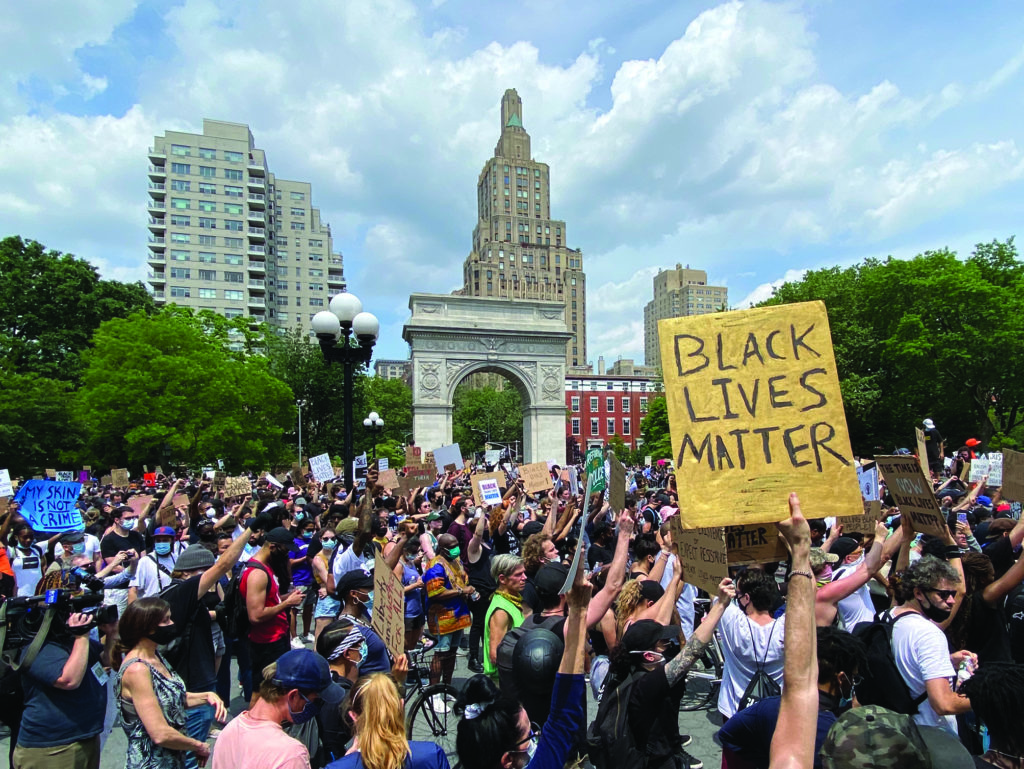
The protests began in the United States and spread further offshore as far as Australia, Israel, Poland and Uganda, moving swiftly across racial, geographical, class, generational and gender boundaries. The Floyd video simultaneously galvanised millions of people into action, giving rise to solidarity between disparate groups on street corners and social networks. International protesters weren’t just bearing witness to – and feeling the suffering of – black people in the US. People of colour in other countries were protesting the manifestations of endemic racism suffered in their own cultural contexts,[18]Jen Kirby, ‘“Black Lives Matter” Has Become a Global Rallying Cry Against Racism and Police Brutality’, Vox, 12 June 2020, <https://www.vox.com/2020/6/12/21285244/black-lives-matter-global-protests-george-floyd-uk-belgium>, accessed 19 November 2020. while many from non-marginalised racial backgrounds offered solidarity. In other words, the whole world was watching, and what they were watching was one another participating in a historic civil-rights movement.
Australians were among the most visible groups to latch on to this movement, focusing in particular on Indigenous deaths in police custody.[19]See Lorena Allam, ‘“Deaths in Our Backyard”: 432 Indigenous Australians Have Died in Custody Since 1991’, The Guardian, 1 June 2020, <https://www.theguardian.com/australia-news/2020/jun/01/deaths-in-our-backyard-432-indigenous-australians-have-died-in-custody-since-2008>, accessed 19 November 2020. Australia’s First Nations communities led over 50,000 protesters across all eight states and territories. Culturally diverse people united to chant, ‘I can’t breathe,’ and took a knee to align themselves with the US Black Lives Matter movement, braving the pandemic and flouting social-distancing rules to march alongside one another. Many marchers around the world followed the lead of embedded journalists and roving reporters; rather than aligning themselves with police patrols,[20]The reality TV show Cops, which had run for thirty-three seasons from 1989, was unceremoniously sent to the electric chair after Floyd’s death went viral. The similarly themed Live PD was also cancelled after reports of their own recording of a black man, Javier Ambler, dying in police custody the previous year. Although the body-cam footage never made it to air, it found its way to YouTube on 8 June 2020. Texas sheriff Robert Chody has since been indicted for evidence tampering after trying to destroy the incriminating footage. See ‘Behind the Fall of Live PD, Cops and Reality TV Police’, The Hollywood Reporter, 17 June 2020, <https://www.hollywoodreporter.com/news/behind-fall-live-pd-cops-reality-tv-police-1298804>; Tony Plohetski, ‘Williamson County Sheriff Robert Chody Indicted in Javier Ambler Case’, Austin American–Statesman, 28 September 2020, <https://www.statesman.com/news/20200928/williamson-county-sheriff-robert-chody-indicted-in-javier-ambler-case>; and ‘Police Body-cam Footage: Javier Ambler’s Fatal Encounter with Williamson County Sheriff’s Deputies’, YouTube, 8 June 2020,<https://www.youtube.com/watch?v=SdTQloYC9_k>, all accessed 19 November 2020. protesters deployed their mobile phones to shift the power dynamic and capture the police instead. Citizens stuck at home also wanted their voices to be heard and showed their support in the form of online activism, helping raise awareness and mobilise others by sharing uploaded videos and spreading the word. Corporations around the world got on board too, risking alienating potential customers by declaring their support for the protests and donating to the Black Lives Matter cause.[21]See Tiffany Hsu, ‘Corporate Voices Get Behind “Black Lives Matter” Cause’, The New York Times, updated 10 June 2020, <https://www.nytimes.com/2020/05/31/business/media/companies-marketing-black-lives-matter-george-floyd.html>; and Mercey Livingston, ‘These Are the Major Brands Donating to the Black Lives Matter Movement’, CNET, 16 June 2020, <https://www.cnet.com/how-to/companies-donating-black-lives-matter/>, both accessed 19 November 2020. Television networks and streaming services belatedly positioned themselves on the side of diversity and inclusion, removing content retrospectively seen as culturally insensitive.[22]See Lauren Morris, ‘All the TV Shows Removed from Netflix, HBO Max and Other Platforms over Blackface Controversy’, Radio Times, 30 June 2020, <https://www.radiotimes.com/news/2020-06-30/tv-shows-removed-blackface/>, accessed 19 November 2020. While this whitewashing of popular culture remains controversial[23]See Mark Harris, ‘The Absolutist Case for Problematic Pop Culture’, Vulture, 10 June 2020, <https://www.vulture.com/article/the-absolutist-case-for-gone-with-the-wind.html>, accessed 17 November 2020. and liable to be viewed as mere virtue signalling,[24]For more on this trend, see Benjamin Riley, ‘Selling Virtue: “Woke” Advertising and Corporate Ethics’, Screen Education, no. 97, 2020, pp. 48–55. such scepticism misses the bigger picture: these companies also wanted to be seen realigning their social identities and public sympathies.
Who watches the watchers?
In the US, protesters and police invariably came into conflict, and the Black Lives Matters movement was increasingly seen through different lenses. Mobile phones and social media have made it possible for citizens to bypass traditional media outlets and challenge official versions of events; protesters have therefore been able to share their own narratives and viewpoints online. Many of the peaceful protesters were independent filmmakers capturing pivotal scenes – group solidarity, chaotic moments, militarised police responses – so that other citizens could bear witness too. Their eyewitness accounts inadvertently created a new phenomenon: crowdsourced links.
Eyewitness reportage on its own often lacks adequate context or a clear throughline. Crowdsourcing, however, has been able to forge links in a chain. Digital activists are collecting, compiling and linking seemingly random footage, images and reports into a more structured web of experiences. One such archive has organised, analysed and stored 1276 videos of police brutality in tabular form.[25]The Google spreadsheet, curated by lawyer T Greg Doucette and mathematician Jason Miller, is available at <https://docs.google.com/spreadsheets/u/1/d/1YmZeSxpz52qT-10tkCjWOwOGkQqle7Wd1P7ZM1wMW0E/htmlview>, accessed 19 November 2020. For more information on this, see Katie Way, ‘Police Violence at Protests Is Undeniable. All the Videos Are Right Here’, VICE, 6 June 2020, <https://www.vice.com/en/article/7kpbmy/police-violence-at-protests-is-undeniable-all-the-videos-are-right-here>, accessed 19 November 2020. The films might have been shot and released out of sequence, but the curators of projects such as these have followed the guiding principle of film editing: it is the order of shots that provides context and meaning.
Numerous videos have since spread to more accessible sites like Policeabuse.com,[26]See <https://www.policeabuse.com/>, accessed 19 November 2020. WatchWatch.org,[27]See <https://watchwatch.org/>, accessed 19 November 2020. The Witness Archive[28]See <https://www.thewitnessarchive.com/>, accessed 19 November 2020. and existing platforms like YouTube. Consequently, it became possible to see a more complete picture in one place at any given time: citizens exercising their lawful right to assemble and protest police brutality were themselves being subjected to widespread instances of police brutality. And despite the prevalence of mobile cameras and mounting evidentiary footage, filming the police – much as was the case in the Floyd video to begin with – appears to have done little to prevent violence against ordinary citizens.
Many of us will have already seen examples of the images that found their way to mainstream news outlets – including footage of a 75-year-old man being knocked to the ground and seemingly left to bleed out,[29]See Luke Harding, ‘New York Police Officers Suspended for Pushing 75-year-old Man to Ground During Protests’, The Guardian, 5 June 2020, <https://www.theguardian.com/us-news/2020/jun/05/buffalo-police-officers-suspended-for-pushing-75-year-old-to-ground-during-protests>, accessed 18 November 2020. a twenty-year-old woman being forcibly thrown into the kerb and having a seizure,[30]See Emerald Bensadoun, ‘“Unacceptable”: Video Shows NYPD Officer Shoving George Floyd Protester to the Ground’, Global News, 30 May 2020, <https://globalnews.ca/news/7006935/nypd-officer-shoves-georgia-floyd-protester/>, accessed 18 November 2020. and a seven-year-old child crying hysterically after being maced by police at close range.[31]See Claudia Farhart, ‘Parents Speak Out After Seattle Police Maced Seven-year-old Protester’, SBS News, 16 June 2020, <https://www.sbs.com.au/news/parents-speak-out-after-seattle-police-maced-seven-year-old-protester>, accessed 18 November 2020. Although citizen journalism is a major line of defence against police offences, it remains an inherently risky endeavour. Police departments, of course, have been watching the people watching (filming) them for years; they’ve created their own databases, and many citizen journalists have since been targeted and harassed for trying to hold police officers to account.[32]See Dragana Kaurin, ‘The Price of Filming Police Violence’, VICE, 27 April 2018, <https://www.vice.com/en/article/evqw9z/filming-police-brutality-retaliation>, accessed 19 November 2020.
We also witnessed the asymmetrical relationship between mainstream news media and Black Lives Matter protesters. Although social media originally led the way, coverage by traditional media outlets helped to promote and legitimate their cause. News organisations obviously didn’t need much convincing once the Floyd video went viral: the movement had its own momentum, and they wanted to be seen making history too. Professional journalists and camera crews stood shoulder to shoulder with peaceful protesters, and were among the people arrested, assaulted, tear-gassed and hit by stun grenades.[33]Poppy Nor, ‘Teargassed, Beaten Up, Arrested: What Freedom of the Press Looks Like in the US Right Now’, The Guardian, 6 June 2020, <https://www.theguardian.com/us-news/2020/jun/06/george-floyd-protests-reporters-press-teargas-arrested>, accessed 19 November 2020. Like ordinary citizens, news organisations were caught up in the emotion of a monumental moment and made-for-TV spectacle. But the media cycle soon moved on, and depictions of protesters gradually became less sympathetic.
Australia’s First Nations people were among the first to experience the lack of symmetry between media coverage and civic participation. Despite the original shows of support, organisers were disheartened to see subsequent turnouts evaporate and a continued unwillingness to engage with Indigenous issues on a communal level.[34]‘Black Lives Matter Protesters in Australia Call for Anti-racism Education, Action on Deaths in Custody’, SBS News, 4 July 2020, <https://www.sbs.com.au/news/black-lives-matter-protesters-in-australia-call-for-anti-racism-education-action-on-deaths-in-custody>, accessed 19 November 2020. The concern is that many Australians only practise performative solidarity and advocacy, using Aboriginal suffering to raise their own social profiles and capital.[35]Mawunyo Gbogbo, ‘How to Support Black Lives Matter After It Stops Trending’, ABC Life, 13 June 2020, <https://www.abc.net.au/life/how-to-support-black-lives-matter-after-it-stops-trending/12340344>, accessed 19 November 2020. This asymmetry manifested itself as a visual signifier: apparently some black lives matter more than others in the media. Specifically, it required the filmed death of a black American for Australians to engage en masse with the suffering of Indigenous people. Part of the problem was inadequate media representation in the first place. Unlike African-Americans in the US, Aboriginal and Torres Strait Islander people are rarely seen or legitimised in the Australian media.[36]As the two documentaries The Australian Dream (Daniel Gordon, 2019) and The Final Quarter (Ian Darling, 2019) readily confirm, Aboriginal AFL player Adam Goodes was subject to racism on national television, and still paid a considerable price for his activism. See Travis Johnson, ‘A Race to the Goal: Adam Goodes’ Story in The Final Quarter and The Australian Dream’, Metro, no. 203, 2020, pp. 76–83. For a broader look at comparative representations of African-American and Indigenous people, see Isabella Higgins, ‘Australia Had Its Own George Floyd Moment, Only It Passed Without International Outrage’, ABC News, 2 June 2020, <https://www.abc.net.au/news/2020-06-02/us-riots-indigenous-deaths-in-custody/12309010>, accessed 24 November 2020. The Indigenous community was treated as an afterthought or byproduct of America’s colonisation of Australia’s consciousness. One benefit did come from the precipitous drop in interest or disengagement from issues of policy and reform, ironically: because the Indigenous Black Lives Matter movement stopped trending locally and quickly fell off the mainstream media’s radar, Indigenous protesters weren’t treated to the hostility that would later be directed at their American counterparts.
Since traditional media remain disinclined to acknowledge their own roles in maintaining structural racism through their representations of reality,[37]See Gavan Titley, Racism and Media, Sage, London, 2019. news organisations invariably reverted to type and reproduced their bias towards the status quo. Specifically, they resumed deploying the tropes of the ‘protest paradigm’[38]This is a media framing that ‘demonizes protesters and marginalizes their causes’. See Summer Harlow et al., ‘Is the Whole World Watching? Building a Typology of Protest Coverage on Social Media from Around the World’, Journalism Studies, vol. 21, no. 11, pp. 1590–608. in order to delegitimise, marginalise and pathologise Black Lives Matters protesters. Consequently, the protesters were increasingly seen through the lens of conflict and criminality. I’m not implying here that the media started peddling fake news; there were instances of rioting and looting as well as peaceful protesting. The issue is one of proportionality or focus, or media framing: social chaos became the main story surrounding the US Black Lives Matter movement. The hierarchy of credibility was thus re-established, and the false moral equivalence between ‘law’ and ‘order’ was redeployed.
While social media and traditional media might have a symbiotic relationship, there is a power struggle over the meaning of shot footage – and it is the viewer who is caught in the middle. Consider the competing media framings over the police shooting in Kenosha, Wisconsin, just under three months after Floyd’s death. The protests and discourse surrounding police brutality and racism failed to prevent a police officer from shooting unarmed black man Jacob Blake in the back at close range four times (an incident caught on camera phone by a neighbour). Kenosha became the site for further protests, and widespread reports of destruction of property and clashes with police drew another crowd from interstate: a militia siding with law and order. A citizen journalist captured footage of white teenager Kyle Rittenhouse fatally shooting two Black Lives Matter protesters two days later with a semi-automatic assault rifle and subsequently being ignored by police as he raised his hands to turn himself in.
What are viewers to make of these films? The enabling assumption is that this kind of eyewitness reportage merely documents and shares ‘the unvarnished truth’. What each of us sees in these two disturbing mobile videos, however, turns the premise of citizen journalism on its head. Citizen journalism serves to reveal a more adulterated or fractured reality than previously acknowledged, as media framing – ideologically motivated angles or perspectives taken on a given news story – also occurs on the receiving end. Or, to quote author Anaïs Nin, ‘We do not see things as they are, we see them as we are.’[39]Anaïs Nin, Seduction of the Minotaur, The Swallow Press, Chicago, 1969, p. 124. Images of a raw, unedited reality therefore become sites of contested and mobilised meanings. Inverting the hierarchy of credibility, as citizen journalism has done, invariably gives rise to conflicting viewpoints or value-laden observations, since the filmmaking process also occurs during the act of viewing.
Endnotes
| 1 | See Steve Rose, ‘Abraham Zapruder: The Man Behind History’s Most Infamous Home Movie’, The Guardian, 15 November 2013, <https://www.theguardian.com/film/2013/nov/14/abraham-zapruder-film-kennedy-killing-parkland>, accessed 17 November 2020. |
|---|---|
| 2 | See Stuart Allan & Einar Thorsen, ‘Introduction’, in Allan & Thorsen (eds), Citizen Journalism: Global Perspectives, Peter Lang, New York, 2009, p. 4. |
| 3 | See my article in the previous issue of Metro for a more critical look at this form of citizen journalism, which seemed intent on spreading misinformation and racial animus through social media: Steven Aoun, ‘Pandemic Paradox: Navigating Technology in the Time of COVID-19’, Metro, no. 206, 2020, pp. 100–5. |
| 4 | US agency We Are Social reports that there are now over 5.19 billion unique mobile-phone users across the globe, and at least 4.54 billion people are connected to the internet in some way. See We Are Social, Digital 2020: Global Digital Overview, 2020, <https://wearesocial.com/digital-2020>, p. 8. |
| 5 | See Jenna Wortham, ‘A “Glorious Poetic Rage”’, The New York Times, 5 June 2020, <https://www.nytimes.com/interactive/2020/07/03/us/george-floyd-protests-crowd-size.html>, accessed 17 November 2020. |
| 6 | Jan Ransom, ‘Amy Cooper Faces Charges After Calling Police on Black Bird-watcher’, The New York Times, updated 14 October 2020, <https://www.nytimes.com/2020/07/06/nyregion/amy-cooper-false-report-charge.html>, accessed 19 November 2020. |
| 7 | Well before the Central Park incident, African-Americans had been reporting increasing incidents of racial profiling on social media. While racial profiling is typically viewed as an aspect of (racist) police policy, many ordinary white people appear to view ‘being black’ as a crime in progress, and routinely call the police when encountering perceived criminals in shared public places. Some of their ‘crimes’ include taking a nap, having a barbecue, sitting at Starbucks, cashing a cheque, mowing a lawn, going to a store, taking a swim and entering their own apartment blocks. See Brett Molina, ‘Cashing Checks, Napping, More Activities Leading to Police Calls on Black People in 2018’, USA Today, 20 December 2018, <https://www.usatoday.com/story/news/nation/2018/12/20/black-people-doing-normal-things-who-had-police-called-them-2018/2374750002/>, accessed 19 November 2020. |
| 8 | See Stephen Egharevba, Police Brutality, Racial Profiling, and Discrimination in the Criminal Justice System, IGI Global, Hershey, PA, 2017. |
| 9 | Joshua Nevett, ‘George Floyd: The Personal Cost of Filming Police Brutality’, BBC News, 11 June 2020, <https://www.bbc.com/news/world-us-canada-52942519>, accessed 17 November 2020. |
| 10 | See ‘RAW: George Floyd Minneapolis Police Body Camera Footage’, YouTube, 10 August 2020, <https://www.youtube.com/watch?v=0gQYMBALDXc>, accessed 19 November 2020. |
| 11 | For a more detailed examination of Floyd’s death, see Judy Melinek, ‘Forensic Pathologist Breaks Down George Floyd’s Death’, MedPage Today, 25 June 2020, <https://www.medpagetoday.com/blogs/working-stiff/86913>, accessed 19 November 2020. |
| 12 | Some relevant statistics can be found at the Mapping Police Violence website, <https://mappingpoliceviolence.org/>, accessed 19 November 2020. |
| 13 | Kaepernick’s goal was twofold: to raise white awareness about black deaths in custody, and to indicate peaceful resistance to systemic racism during the playing of the US national anthem. See Les Carpenter, ‘Kaepernick’s Anthem Protest Is Perfect Way to Highlight America’s Race Problem’, The Guardian, 9 September 2016, <https://www.theguardian.com/sport/2016/sep/09/colin-kaepernick-national-anthem-protest-nfl-race-issues>, accessed 19 November 2020. |
| 14 | Kenya Evelyn, ‘CEO Caught on Video Confronting Neighbour over Black Lives Matter Message’, The Guardian, 16 June 2020, <https://www.theguardian.com/us-news/2020/jun/15/ceo-lisa-alexander-faces-backlash-video-berating-james-juanillo>, accessed 19 November 2020. |
| 15 | See Howard S Becker, ‘Whose Side Are We On?’, Social Problems, vol. 14, no. 3, Winter 1967, p. 241. |
| 16 | See Evan Hill et al., ‘How George Floyd Was Killed in Police Custody’, The New York Times, updated 5 November 2020, <https://www.nytimes.com/2020/05/31/us/george-floyd-investigation.html>; and Dalton Bennett, Joyce Sohyun Lee & Sarah Cahlan, ‘The Death of George Floyd: What Video and Other Records Show About His Final Minutes’, The Washington Post, 30 May 2020, <https://www.washingtonpost.com/nation/2020/05/30/video-timeline-george-floyd-death/>, both accessed 19 November 2020. |
| 17 | See Jonathan Markovitz, Racial Spectacles: Explorations in Media, Race, and Justice, Routledge, New York & Abingdon, UK, 2011. |
| 18 | Jen Kirby, ‘“Black Lives Matter” Has Become a Global Rallying Cry Against Racism and Police Brutality’, Vox, 12 June 2020, <https://www.vox.com/2020/6/12/21285244/black-lives-matter-global-protests-george-floyd-uk-belgium>, accessed 19 November 2020. |
| 19 | See Lorena Allam, ‘“Deaths in Our Backyard”: 432 Indigenous Australians Have Died in Custody Since 1991’, The Guardian, 1 June 2020, <https://www.theguardian.com/australia-news/2020/jun/01/deaths-in-our-backyard-432-indigenous-australians-have-died-in-custody-since-2008>, accessed 19 November 2020. |
| 20 | The reality TV show Cops, which had run for thirty-three seasons from 1989, was unceremoniously sent to the electric chair after Floyd’s death went viral. The similarly themed Live PD was also cancelled after reports of their own recording of a black man, Javier Ambler, dying in police custody the previous year. Although the body-cam footage never made it to air, it found its way to YouTube on 8 June 2020. Texas sheriff Robert Chody has since been indicted for evidence tampering after trying to destroy the incriminating footage. See ‘Behind the Fall of Live PD, Cops and Reality TV Police’, The Hollywood Reporter, 17 June 2020, <https://www.hollywoodreporter.com/news/behind-fall-live-pd-cops-reality-tv-police-1298804>; Tony Plohetski, ‘Williamson County Sheriff Robert Chody Indicted in Javier Ambler Case’, Austin American–Statesman, 28 September 2020, <https://www.statesman.com/news/20200928/williamson-county-sheriff-robert-chody-indicted-in-javier-ambler-case>; and ‘Police Body-cam Footage: Javier Ambler’s Fatal Encounter with Williamson County Sheriff’s Deputies’, YouTube, 8 June 2020,<https://www.youtube.com/watch?v=SdTQloYC9_k>, all accessed 19 November 2020. |
| 21 | See Tiffany Hsu, ‘Corporate Voices Get Behind “Black Lives Matter” Cause’, The New York Times, updated 10 June 2020, <https://www.nytimes.com/2020/05/31/business/media/companies-marketing-black-lives-matter-george-floyd.html>; and Mercey Livingston, ‘These Are the Major Brands Donating to the Black Lives Matter Movement’, CNET, 16 June 2020, <https://www.cnet.com/how-to/companies-donating-black-lives-matter/>, both accessed 19 November 2020. |
| 22 | See Lauren Morris, ‘All the TV Shows Removed from Netflix, HBO Max and Other Platforms over Blackface Controversy’, Radio Times, 30 June 2020, <https://www.radiotimes.com/news/2020-06-30/tv-shows-removed-blackface/>, accessed 19 November 2020. |
| 23 | See Mark Harris, ‘The Absolutist Case for Problematic Pop Culture’, Vulture, 10 June 2020, <https://www.vulture.com/article/the-absolutist-case-for-gone-with-the-wind.html>, accessed 17 November 2020. |
| 24 | For more on this trend, see Benjamin Riley, ‘Selling Virtue: “Woke” Advertising and Corporate Ethics’, Screen Education, no. 97, 2020, pp. 48–55. |
| 25 | The Google spreadsheet, curated by lawyer T Greg Doucette and mathematician Jason Miller, is available at <https://docs.google.com/spreadsheets/u/1/d/1YmZeSxpz52qT-10tkCjWOwOGkQqle7Wd1P7ZM1wMW0E/htmlview>, accessed 19 November 2020. For more information on this, see Katie Way, ‘Police Violence at Protests Is Undeniable. All the Videos Are Right Here’, VICE, 6 June 2020, <https://www.vice.com/en/article/7kpbmy/police-violence-at-protests-is-undeniable-all-the-videos-are-right-here>, accessed 19 November 2020. |
| 26 | See <https://www.policeabuse.com/>, accessed 19 November 2020. |
| 27 | See <https://watchwatch.org/>, accessed 19 November 2020. |
| 28 | See <https://www.thewitnessarchive.com/>, accessed 19 November 2020. |
| 29 | See Luke Harding, ‘New York Police Officers Suspended for Pushing 75-year-old Man to Ground During Protests’, The Guardian, 5 June 2020, <https://www.theguardian.com/us-news/2020/jun/05/buffalo-police-officers-suspended-for-pushing-75-year-old-to-ground-during-protests>, accessed 18 November 2020. |
| 30 | See Emerald Bensadoun, ‘“Unacceptable”: Video Shows NYPD Officer Shoving George Floyd Protester to the Ground’, Global News, 30 May 2020, <https://globalnews.ca/news/7006935/nypd-officer-shoves-georgia-floyd-protester/>, accessed 18 November 2020. |
| 31 | See Claudia Farhart, ‘Parents Speak Out After Seattle Police Maced Seven-year-old Protester’, SBS News, 16 June 2020, <https://www.sbs.com.au/news/parents-speak-out-after-seattle-police-maced-seven-year-old-protester>, accessed 18 November 2020. |
| 32 | See Dragana Kaurin, ‘The Price of Filming Police Violence’, VICE, 27 April 2018, <https://www.vice.com/en/article/evqw9z/filming-police-brutality-retaliation>, accessed 19 November 2020. |
| 33 | Poppy Nor, ‘Teargassed, Beaten Up, Arrested: What Freedom of the Press Looks Like in the US Right Now’, The Guardian, 6 June 2020, <https://www.theguardian.com/us-news/2020/jun/06/george-floyd-protests-reporters-press-teargas-arrested>, accessed 19 November 2020. |
| 34 | ‘Black Lives Matter Protesters in Australia Call for Anti-racism Education, Action on Deaths in Custody’, SBS News, 4 July 2020, <https://www.sbs.com.au/news/black-lives-matter-protesters-in-australia-call-for-anti-racism-education-action-on-deaths-in-custody>, accessed 19 November 2020. |
| 35 | Mawunyo Gbogbo, ‘How to Support Black Lives Matter After It Stops Trending’, ABC Life, 13 June 2020, <https://www.abc.net.au/life/how-to-support-black-lives-matter-after-it-stops-trending/12340344>, accessed 19 November 2020. |
| 36 | As the two documentaries The Australian Dream (Daniel Gordon, 2019) and The Final Quarter (Ian Darling, 2019) readily confirm, Aboriginal AFL player Adam Goodes was subject to racism on national television, and still paid a considerable price for his activism. See Travis Johnson, ‘A Race to the Goal: Adam Goodes’ Story in The Final Quarter and The Australian Dream’, Metro, no. 203, 2020, pp. 76–83. For a broader look at comparative representations of African-American and Indigenous people, see Isabella Higgins, ‘Australia Had Its Own George Floyd Moment, Only It Passed Without International Outrage’, ABC News, 2 June 2020, <https://www.abc.net.au/news/2020-06-02/us-riots-indigenous-deaths-in-custody/12309010>, accessed 24 November 2020. |
| 37 | See Gavan Titley, Racism and Media, Sage, London, 2019. |
| 38 | This is a media framing that ‘demonizes protesters and marginalizes their causes’. See Summer Harlow et al., ‘Is the Whole World Watching? Building a Typology of Protest Coverage on Social Media from Around the World’, Journalism Studies, vol. 21, no. 11, pp. 1590–608. |
| 39 | Anaïs Nin, Seduction of the Minotaur, The Swallow Press, Chicago, 1969, p. 124. |
